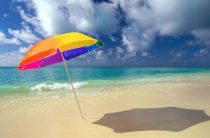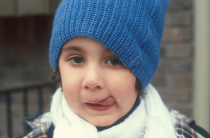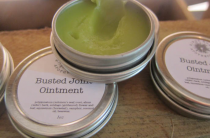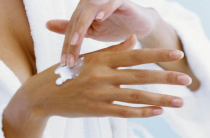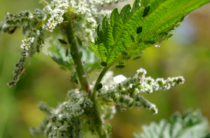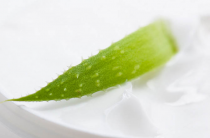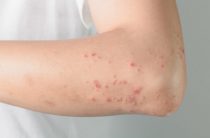The child's body, and in particular its immune system, is quite vulnerable to all irritants and is prone to allergic manifestations. The most common among them can be considered urticaria. It affects both older children and toddlers. Parents should know how to identify the disease in their child and cure it. Such knowledge will help to avoid the severe course of urticaria and its transition to a chronic form.
The manifestation of urticaria in a child
Parents can observe the first manifestations in their child from the age of three months. Urticaria is a red rash on the body of various shapes and locations, a symptom of an allergy. You can recognize it by the following features:
- Pink or red spots on the skin, blisters. Often the rash resembles mosquito bites;
- Itching and burning wounds;
- Accumulation of fluid in pimples.
The rash can appear both in the place of direct contact with the allergen, and spread over the entire surface of the body. Sometimes blisters can reach 10-12 centimeters in size. Often spots of small sizes merge together. Particular attention should be paid to the following symptoms, as they may indicate a severe form of the disease:
- High body temperature;
- Joint pain in a child;
- Swelling of the eyelids and neck;
- Difficulty breathing and pain when swallowing;
- Rapid heartbeat.
All these signs can lead to the loss of consciousness of the baby, or even worse, to anaphylactic shock.
Causes of hives in children
There are a lot of reasons for the appearance of this symptom, which complicates its identification and proper timely treatment. Children suffer from chronic urticaria due to the factor of heredity. In this case, it is almost impossible to save the child from torment, it will occur again and again. You can only make it easier. Often this form has an autoimmune character.
Before will often children suffer from rashes for some physical reasons such as:
| Pressure drops | vibrations | Cold |
| climate change | Ultraviolet | Mechanical damage |
| polluted water | Contact with plants |
Urticaria can manifest itself against the background of various diseases. So, if the child is sick with infectious diseases, the rash occurs on the hands and face. In young children, worms and helminths are often found, which provoke a reaction in the body. With problems with the hormonal background and the lymphatic system, red pimples appear on the skin of children.
Food
With the start of complementary foods, babies can suffer from a disease such as food allergies. Its characteristic manifestation is dermatitis and urticaria. There are attacks of suffocation or dry cough. Therefore, it is recommended for as long as possible, at least up to a year, to breastfeed the baby only. Among the products that provoke a skin reaction, the following are noted:
- Seafood;
- Milk and eggs;
- Nuts;
- Fruits.
Almost all of the child's favorite sweets can be called the culprits of the symptom. Therefore, it is worth limiting their use, and some even completely eliminated. Explain to him that the use of sweets, cakes and ice cream should be stopped for a while. The same is true with baked goods. When feeding, try to give not a fresh piece of bread, but at least one day old.
Often, mothers, trying to saturate the child's diet with vitamins, stuff him with fruits and vegetables. So it's worth knowing that excessive consumption of strawberries, raspberries, cherries, tomatoes, pumpkins and carrots leads to skin reactions. Such products should be introduced gradually in very small doses. If you notice hives after drinking cow's milk, then replace it with soy or goat milk. Goat's milk is much healthier, has a significant advantage over cow's.
Medicines
When a child uses certain medications, a reaction such as urticaria occurs. The dangerous group includes:
- Antibiotics (tetracycline, penicillin, polymyxin);
- Anti-inflammatory drugs;
- Vaccinations.
Caution should be taken in the selection of ointments for children. There are cases of the appearance of such a disease as urticaria in children after taking antihistamines. Therefore, before running to the pharmacy for a medicine, you should consult a doctor.
Environment
This factor is one of the most common. The culprit of hives in children can be a pet. It is known that in the body of a cat and a cat a harmful protein is produced, which is excreted and distributed through saliva and urine. The places of its deployment are absolutely diverse: wool, furniture, dishes, clothes, air. It is worth noting that the opinion about the hypoallergenicity of hairless cat breeds is a profound delusion.
It is necessary to monitor the cleanliness of the house and maintain the level of temperature and humidity in it. Try to prevent the penetration of street dust into the room. The condition of the baby's skin is also affected by cigarette smoke. Therefore, parents need to give up this addiction.
Do not let your baby come into contact with household chemicals. When washing his clothes, rinse the linen at least three times. To maintain his personal hygiene, buy only hypoallergenic cosmetics in pharmacies. The child's skin should only come into contact with natural fabrics - no synthetics. Keep an eye on the condition of his toys. Treat them regularly without the use of chemicals. It is known that any carpet upholstered furniture are a kind of dust collectors. In order not to cause allergies in a child, you need to get rid of them. The floor should be covered with linoleum or laminate.
An important role is played by the psychological and emotional atmosphere in the family. Even at a subconscious level, a child's body can react to screams and quarrels. This is how children develop diseases with unexplained reasons.
Methods for treating hives in babies
The main thing in the treatment is the elimination of the cause. Parents should monitor what the child eats during the day and eliminate all foods with a high degree of allergenicity, as well as sweet carbonated drinks. Insects and plant pollen often cause hives in children, so go outside less often. If food is the cause, give the child an enema or dilute activated charcoal in water.
Medical treatment
When prescribing drug therapy, doctors resort to the use of such drugs:
- sedatives;
- Hormonal preparations;
- antihistamines;
- Sorbents.
Among the antihistamines, children are allowed to take the following:
| Suprastin | The most common drug for the treatment of urticaria in children. Allowed from the age of one month. Doctors often attribute suprastin injections. The effect comes quickly enough. Although the drug belongs to the first generation of antihistamines, it does not affect the children's nervous system, provided that the prescribed dosage is observed. |
| Tavegil | The tool has a fairly long period of action. Does not affect the nervous system. There are three forms of release: tablets, injections and syrup. Children from the age of six are allowed to use in the form of tablets. And from one year you can use syrup. Effectively fights against any manifestations of allergies, dermatitis and diathesis. |
| Fenkarol | The drug reduces the amount and production of histamine in the child's body, eliminates any skin manifestations. The effect occurs within 20 minutes after consumption. Since the drug is available only in tablets, it is advisable for children to take it from the age of two. |
| Peritol | An antihistamine indicated for the treatment of hives in children and other allergic manifestations such as rhinitis and dry cough. According to many studies, it was found that the drug also has a calming effect. It is very convenient for use by children under three years old, as it is available in the form of a syrup. |
| Zyrtec | Effective for hay fever. Children are allowed from the age of six months, preferably in the form of oral drops. Tablets are allowed to be given from the age of three. The drug eliminates such an ailment as hives in children. |
| Tsetrin | The drug is good because it is available both in the form of tablets and in syrup. Therefore, it is suitable for children of all ages. The tool will help remove signs of hives and other allergic manifestations within half an hour after taking the drug. The action after drinking the syrup comes a little later. Cetrin prevents the spread of the rash and the allergen in the body. |
With swelling and rashes on the skin, children often increase excitability. To calm their nervous system, it is recommended to take some sedatives. As a rule, they are made only from natural ingredients and do not have any side reactions. But the main condition for their admission is the observance of the correct dosage.
First of all, I would like to mention the well-known valerian. In the form of tablets, it is allowed from three years. And if used in the form of infusion - from one year. Valerian will help normalize the child's sleep, which is disturbed due to discomfort and frequent itching with hives. Among the more modern drugs, Persen and Magne B6 should be noted. The first of them in its composition contains an extract of lemon balm, mint and valerian. Children are prescribed from the age of three with insomnia and increased excitability. As for Magne B6, the remedy contains B vitamins, which normalize the work of the whole organism and facilitate the course of urticaria in children.
If you notice a skin rash in your baby, be sure to give him sorbents. They contribute to the rapid removal of allergens and other accumulated toxins from his body. Even infants are allowed the following of them:
- Enterosgel;
- Polyphepan;
- Smecta;
- Polysorb MP.
These drugs have a rather mild effect on the child's body, not only do not violate the intestinal microflora, but restore it by removing harmful substances. Enterosgel creates an enveloping film in the gastrointestinal tract, thereby preventing the penetration of allergens. After the release of the body, urticaria in children disappears. With its mild manifestations, it will be enough to use only these drugs.
Folk methods of getting rid of urticaria
In the treatment of urticaria in children, the experience of our ancestors can help. A huge number of recipes have come down to our times, having passed checks and tests. Therefore, we can say with confidence that traditional medicine is quite effective and reliable in solving this issue. But, nevertheless, when treating a child with herbs, it is worth consulting with a doctor to determine the risk of allergic manifestations to such methods of treatment. When all the risks are identified, and nothing threatens your child, you can use the following recipes:
- Grate the celery root and stalk and pass through cheesecloth. Give the squeezed juice to the child a couple of spoons before meals. It will help remove excess fluid from the body.
- Grated potatoes are used as lotions for hives in children. On the skin cleansed with hydrogen peroxide, apply a potato compress for half an hour. It will help reduce the area of \u200b\u200bthe spread of the rash, cool the skin and relieve itching.
- Brew your baby with mint tea. You need to drink it several times a day. It, like celery, has a diuretic effect and has a calming effect on the nervous system of your child.
Quite effective are compresses from propolis tincture. Well, there is no doubt about the healing properties of chamomile. It should be taken in any form: baths, decoctions, tea, compresses, lotions. To relieve itching with hives in a child, an oatmeal bath helps well. First, boil a few tablespoons of porridge in a glass of boiling water. Let it brew for about an hour. Then, thoroughly mixing and breaking the grains, pour into a common warm bath. For babies, the recommended time spent in such water is from 10 to 15 minutes. Decoctions of calendula, lemon balm or string are also often added to the bath. These herbs are recommended by pediatricians.
In the treatment of its acute form, a decoction of nettle is used. Boil a couple of tablespoons of herbs in 0.5 liters of water for three minutes. Before straining the broth, it must be insisted for exactly one hour. The decoction is applied to a cloth, gauze or cotton pad, and applied to the baby's affected skin. If your child's hives are the result of a reaction to cold, use warm olive oil to lubricate the skin. In this case, St. John's wort and rose hips can also help. These ingredients must be infused in boiling water for three hours. It is used as lotions (applied no longer than ten minutes) or baths.
If urticaria is provoked by nervous strain or stress, it would be appropriate to use a mixture of drops of valerian and hawthorn. Dilute 15 drops of each in 50 ml of water and let your child drink before bed. Mata is also used for this purpose.
Diet for hives in a child
Very important for the treatment of urticaria in children is the correct diet. At this time, it is necessary to radically change it, because most products provoke the production of histamine. If urticaria is observed in children under one and a half years of age, then it is necessary to stop feeding them and return to breastfeeding for a while. Entering complementary foods begins after the complete disappearance of signs of urticaria. Products new to the baby are used with a difference of two weeks in very small doses.
During the period of exacerbation of urticaria, the following foods should be avoided:
| Honey, chocolate | Strong tea | Salty and fatty foods |
| Sparkling water | All flour | Smoked meats |
| Walnuts | Strawberry Raspberry | Almond, hazelnut |
| Eggs | Cherry, tomato | Pumpkin |
Also, parents should forget about the use of various spices and seasonings in cooking. Carefully let your child eat fish, cottage cheese and sour cream. In a small amount, yogurt is allowed without any flavorings. The use of semolina is strictly prohibited. There is a list of products that must be included in the children's menu for hives:
| boiled vegetables | Turkey | Vegetable stew | Beef |
| Koops on the water | white currant | Rabbit | green apples |
Children are advised to drink weak green tea or dried fruit compote. Bread should be eaten only of the second grade, and meat should be boiled or baked. Some pediatricians recommend that mothers replace cow's milk with goat's. Many vegetables are allowed for consumption: broccoli, zucchini, cauliflower, cucumber (but not young), lettuce. They can be dressed with refined sunflower or olive oil. But the most useful is flax oil. You can use the following tips and examples of your child's daily diet:
- For breakfast, boiled rabbit and cabbage salad are suitable. It's a good idea to start your day with oatmeal with apples and weak green tea. Buckwheat is considered the most useful among cereals. Boiled in water, it will fit perfectly into the menu of a child with hives. Sometimes the baby can be given to drink kefir. You can use baked apples to replace sweets.
- For lunch, try to cook vegetable or clear broths. For these purposes, use only dietary meat, and when cooking the broth, it should be drained at least three times. Make pea soup or mashed potato soup more often. For the second, you can use any porridge with steam cutlets or meatballs. Children are very fond of carrot pancakes.
- Dinner should be light. You can try to boil a piece of fish for a baby, cook a potato casserole.
As soon as all signs of hives in a child pass, do not rush to return to the previous diet. Everything should happen in a clear sequence. In remission, you can gradually introduce some fruits and vegetables. You need to start with yellow products. Also, take your time with freshly squeezed juices and fruit purees. You can start introducing fermented milk products that will help normalize the intestinal microflora.
It is recommended that you keep a food diary for your child. It contains all the information about the nutrition of the baby. It is important to indicate the exact time of eating, its quantity and components. If the urticaria begins to manifest itself, it is worth noting and writing down the alleged allergen product, which is excluded from the diet in the future. It is important to observe fractional meals and make sure that the child does not overeat. The presence of such a diary will greatly facilitate the work of the doctor and speed up the process of treating a child from urticaria.
